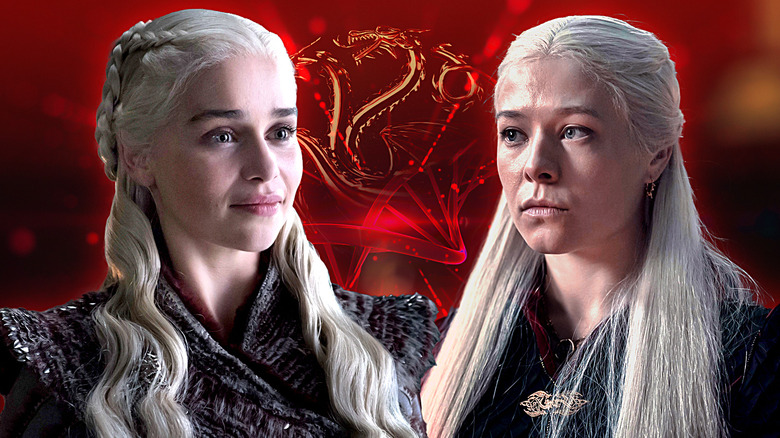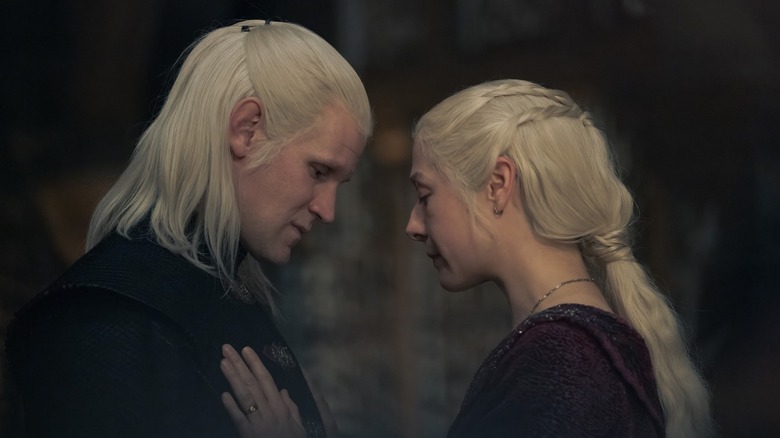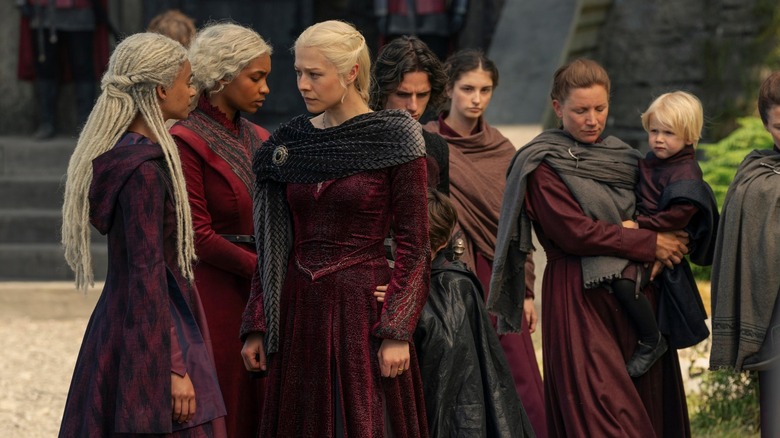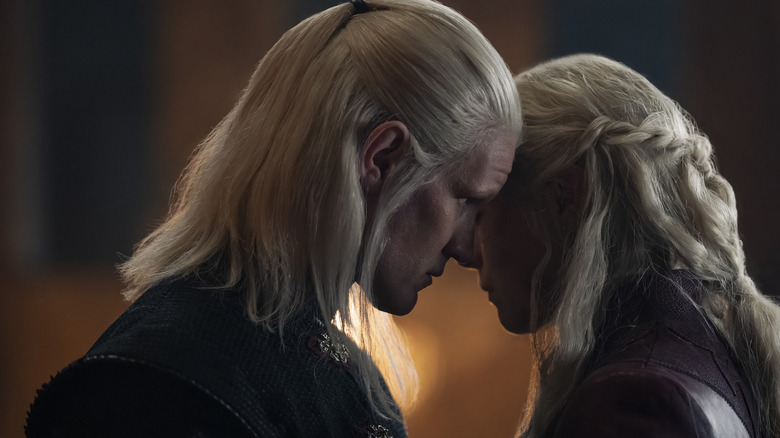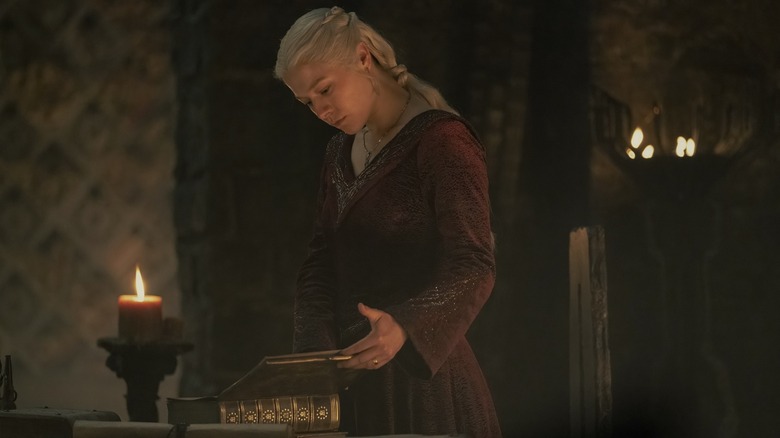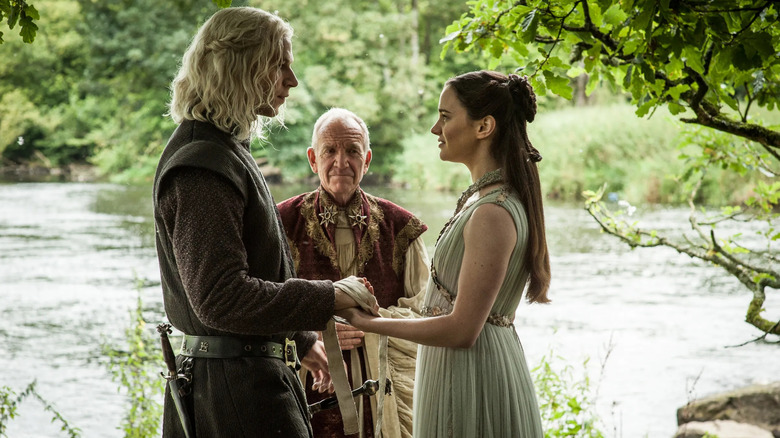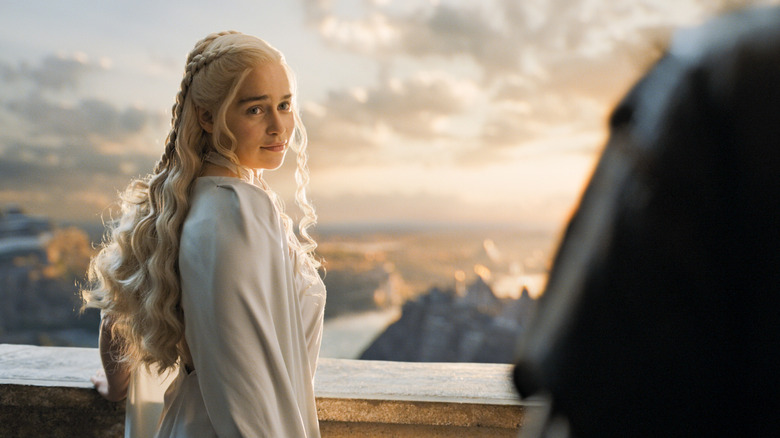How Is House Of The Dragon's Rhaenyra Targaryen Related To Daenerys?
When "Game of Thrones" first premiered in 2011, fans fell in love with Daenerys Targaryen, the "Mother of Dragons" played by Emilia Clarke who ended the show's wildly successful first season rising from her husband's funeral pyre with three baby dragons to her name borne from ancient eggs belonging to her family line. (No, really; people ended up naming their kids "Daenerys" and "Khaleesi" once the series really took off, which might have felt like a misstep after the series finale made Daenerys into an insane tyrant, but I digress.) "Game of Thrones" came to a close in 2019 and its first official spin-off, the prequel "House of the Dragon," began its run on HBO in 2022, introducing the world to another powerful Targaryen queen: Rhaenyra Targaryen, played as a teenager by Milly Alcock and as an adult by Emma D'Arcy. The two women are pretty similar in many ways: they both want to rule the Seven Kingdoms despite fierce opposition, both battle upon dragonback, and both end up experiencing brief triumphs before their reigns are cut brutally short (by their deaths, specifically).
So how are the two related, since they quite obviously are? The two women are eight generations apart, and as a result, Rhaenyra, whose life and reign predate Daenerys by hundreds of years, is Daenerys' sixth great-grandmother. Despite Rhaenyra's difficulties as a ruler amidst the Targaryen civil war known as the Dance of the Dragons, she does manage to keep at least a few of her children alive, and though a few of them end up ruling Westeros after her defeat and downfall, it's not a totally direct line to Daenerys. Here's how Rhaenyra's Targaryen lineage leads directly to Daenerys and her quest to take the Iron Throne back for the ancient family.
Rhaenyra and Daemon have a son named Viserys II
Fans of "House of the Dragon" know that, after the time jump in season 1, Rhaenyra ends up neatly disposing of her husband Laenor Velaryon (John MacMillan) — in that they fake his death so he can escape Westeros and live freely as a queer man — and marrying her own uncle, Prince Daemon Targaryen, played by "Doctor Who" and "Morbius" alum Matt Smith. (Incest is quite common in the "Game of Thrones" franchise, as fans also know.) Rhaenyra and Daemon have a handful of children together: Aegon Targaryen, Viserys Targaryen, and Visenya Targaryen.
Rhaenyra's two eldest children — who were secretly fathered by a knight of the Kingsguard — both perish during the Dance of the Dragons, and sadly, the young Princess Visenya was stillborn, but both Aegon and Viserys end up ruling after the Dance of the Dragons finally ends. After Aegon II Targaryen (played on-screen by Tom Glynn-Carney) dies, Rhaenyra's oldest remaining son Aegon takes the title of King Aegon III — and nicknames that range from "the Unlucky," "the Unhappy," "the Broken King," and "the Dragonbane" — and installs his younger brother Viserys as his Hand of the King. (In both the series and George R.R. Martin's Targaryen family history "Fire & Blood," Rhaenyra wisely stashes the two boys in Pentos, across the Narrow Sea, during the civil war, allowing them to survive.) After Aegon III's 26-year rule came to an end with his death, his two sons Daeron I Targaryen and Baelor I Targaryen reigned — with Viserys by their respective sides — before Viserys took the throne in 171 A.C. (with AC meaning "After the Conquest").
Viserys fathered a monarch known as the Good King
Viserys II Targaryen actually has some competition for the Iron Throne in the form of Baelor's sister-wife Daena Targaryen — the daughter of Viserys' brother King Aegon III — but because Daena doesn't have much support at court and people are hesitant to install a female monarch with Rhaenyra's disastrous rule in mind, Viserys ends up taking the throne. Viserys only rules for about a year after he suddenly falls ill and dies, and rumors swirl that his son Aegon — who becomes King Aegon IV after Viserys II dies — is responsible somehow, but that's never ultimately proven.
King Aegon IV does earn a somewhat awkward nickname as a result of these rumors, though; he's dubbed "Aegon the Unworthy" and is largely believed to be one of the worst Targaryen kings in the family's history. Though George R.R. Martin officially ends the narrative of "Fire & Blood" after Aegon III's rule — and apparently plans to release another part eventually — he does weigh in on Aegon the Unworthy in an interview at the end of the book. After saying he'll address Baelor and Viserys II's rules, Martin says he'll then tackle "Aegon the Unworthy," who "takes over, and he's a very colorful figure. I obviously drew on Henry VIII for him—Henry VIII had six wives, Aegon the Unworthy had nine mistresses." Martin is right; Aegon IV absolutely sucks. He's corrupt, loves opulence and decadence (at the expense of the kingdom), gave wealth to some and directly took it from others, and was essentially an irredeemable jerk. Aegon IV ends up dying in 184 A.C. after ruling for a dozen years (with his cause of death attributed to his morbid obesity and poor hygiene), and though he had a whole host of bastards thanks to his nine mistresses, his son Daeron II Targaryen becomes king.
Daeron's son King Maekar I didn't participate in a time-honored Targaryen tradition
After Aegon IV did his best to screw up the entirety of Westeros, his son Daeron II Targaryen smoothed things over by earning the nickname "Daeron the Good," being generally smart and kind and doing a better job than his father (despite the incredibly low standard set for him in the first place). Daeron II, who married Myriah Martell of Dorne, dealt with the First Blackfyre Rebellion (which pitted Daeron against his half-sibling and Aegon IV's bastard Daemon Blackfyre) but managed to quash it, but the worst tragedy of his life was yet to come. After Daeron's eldest son Baelor Breakspear dies during a traditional Andal "trial of the seven" — by accident at the hand of his brother Maekar — Daeron contracts an illness shortly thereafter in 209 A.C., at which point the throne passes to his second-eldest son Aerys I Targaryen. Aerys, known for being erudite and bookish and, marries his cousin Lady Aelinor Penrose, but it's rumored that he never consummates the marriage, preferring the company of his texts; Aerys dies after a 12 year rule and, after a bunch of other Targaryens randomly die in quick succession, passes the throne to his younger brother Maekar.
Like his father before him, Maekar I Targaryen eschews a particularly odd Targaryen tradition in that he does not marry or procreate with someone who shares his bloodline. Maekar — who will appear in another "Game of Thrones" spinoff, the forthcoming "A Knight of the Seven Kingdoms" — marries the noblewoman Lady Dyanna Dayne before he ever takes the throne and she dies before he becomes king, but the two do have a handful of heirs before her passing, and amidst political turmoil in Westeros, Maekar dies in battle in 233 A.C. after another 12-year reign. A council is summoned to vote, and Maekar's son Aegon is chosen as the next monarch.
Maekar's son Aegon V has a pretty terrible royal nickname
Aegon V Targaryen was really never meant to be king. As the fourth son of Maekar I Targaryen, Aegon only sits on the Iron Throne because other people, including his older brother Aemon Targaryen (who appears as Maester Aemon in "Game of Thrones" and is played by Peter Vaughan), refuse to do so, and he earns the nickname "Aegon the Unlikely." Aegon's other nickname? Egg, which will probably seem familiar to fans of George R.R. Martin's novellas "A Tale of Dunk and Egg," chronicling the pre-Iron Throne adventures of Egg and his best buddy Ser Duncan Tall, Egg's eventual Lord Commander of the Kingsguard. (The two will also appear in the "A Knight of the Seven Kingdoms" series.)
Despite that unfortunate nickname, Aegon is a pretty good king, despite constant political issues — specifically, those pesky Blackfyres again — and a particularly harsh and long winter, though he does make an unprecedented effort to send aid to those in need (especially the northern citizens of Westeros). Aegon faced a number of uprisings throughout his reign — and even though he made a valiant effort to arrange marriages between his heirs and the children of powerful houses to forge alliances, much of it was in vain, and his death was particularly tragic. In 259 A.C., a Targaryen palace called Summerhall catches fire and kills Aegon V, Ser Duncan the Tall, and Aegon's eldest son Duncan Targaryen. So who takes the throne after Aegon's untimely death? His second son, Jaehaerys II.
King Jaehaerys II and his sister-wife have two children — and those children get married
Aegon V may have tried to marry his children off to other great houses of Westeros, but his son and eventual heir King Jaehaerys II kept it in the family (like so many Targaryens before him). Jaehaerys was supposed to marry Celia Tully (of, obviously, House Tully), but fell in love with and married his sister Shaera instead, reigniting the Targaryen tradition of incest after it took a few generations off. (Before his death at Summerhall, Jaehaerys' older brother Duncan something quite similar, marrying a common-born girl instead of a daughter of House Baratheon and royally pissing off Aegon V.)
Jaehaerys' reign only lasts for three years, during which he proved to be a relatively solid leader — encouraged by Ser Barristan Selmy, a vital character in "Game of Thrones" played by Ian McElhinney — and he and Shaera manage to produce two children: Aerys II Targaryen and Rhaella Targaryen. Unfortunately, Jaehaerys' health was quite literally never good, so after a very short rule, he falls ill at the age of 37 and dies in 262 A.C. Aerys II is the obvious and perhaps only choice for the throne, and like his father before him ... he marries his sister, Rhaella!
There's one other major thing where Aerys II is concerned, though; he's the "Mad King" constantly mentioned in "Game of Thrones" who's ultimately taken down by King Robert Baratheon I (Mark Addy) — or, more specifically, killed by his own soldier Ser Jaime Lannister (Nikolaj Coster-Waldau), who earns the thankless nickname Kingslayer as a result — and sets a serious precedent for the events of "Game of Thrones." Let's get back to Aerys' relationship with Rhaella, though; the two have a whole host of children together, but only three survive.
Aerys and Rhaella's three children are Rhaegar, Viserys, and ... Daenerys
Aerys I Targaryen didn't start his life — or reign — as the "Mad King," but by the end of his days, he definitely earned the moniker — and thanks to his downfall, all of his three surviving children were left unable to take the Iron Throne. Though Aerys arranged for his eldest son Rhaegar Targaryen to marry Elia Martell of Dorne before Aerys' own downfall, Rhaegar secretly weds Lyanna Stark, the noble sister of Ned Stark (played on "Game of Thrones" by Sean Bean), and the two have a child together: Aegon Targaryen, eventually revealed to be the apparent Stark bastard Jon Snow (Kit Harington). (It's important to note that Rhaegar and Elia Martell also marry and have children together, but Elia and her children are brutally murdered by Ser Gregor Clegane, played in the series by Hafþór Júlíus Björnsson, leading directly to the grudge held by Pedro Pascal's beloved character Oberyn Martell.) Rhaegar is killed in combat, so what about his siblings Viserys and Daenerys?
Both Viserys and Daenerys end up exiled to Braavos for their own safety, which is specifically where "Game of Thrones" picks up this narrative thread. As we all know, Viserys (Harry Lloyd) is a cruel and power-hungry little twerp who marries Daenerys off to the Dothraki horse lord Khal Drogo (Jason Momoa), eventually writing his own death certificate as soon as he pisses Drogo off (Drogo, at this point, has fallen for Daenerys and kills Viserys partly to protect his wife and their unborn child). Daenerys decides to retake her rightful spot on the Iron Throne, and the rest is history.
"House of the Dragon" and "Game of Thrones" are both streaming on Max now.
